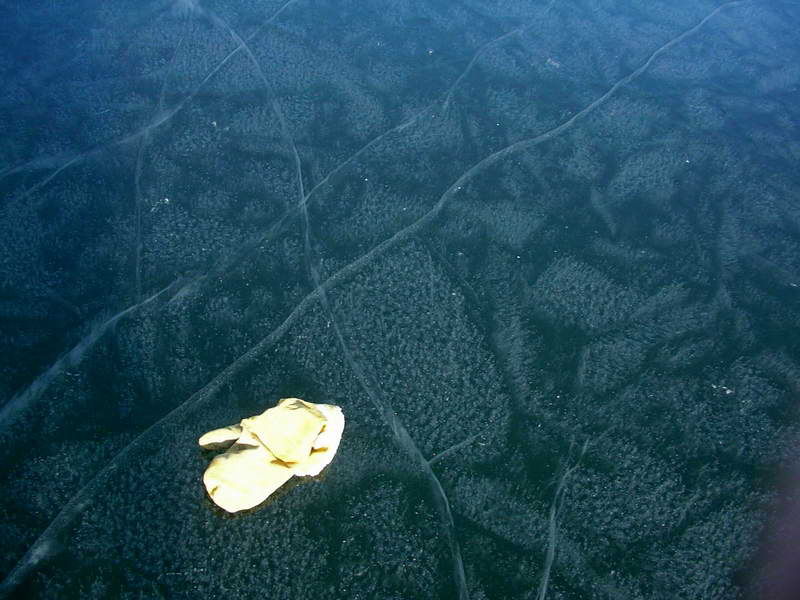 As black ice ages the grain boundaries get more visble. They are the dark lines in this picture.
As black ice ages the grain boundaries get more visble. They are the dark lines in this picture.
Ice Grain Types
Ice is a crystalline solid whose crystals are usually called grains. The grain boundaries are often visible internally in clear black ice or on the surface of thawing ice. Grains come in a wide range of size from 0.05" to several feet. An individual section of ice typically has grains that are roughly the same size, making it reasonable to classify a section of ice into 'small grain' or 'large grain' types. Small and large grain ice have different formation mechanisms that we discuss in more detail in the Ice Science section. Grain size is more than a technical curiosity as, in an advanced thaw state, small grain ice can be much weaker than adjacent large grain ice.
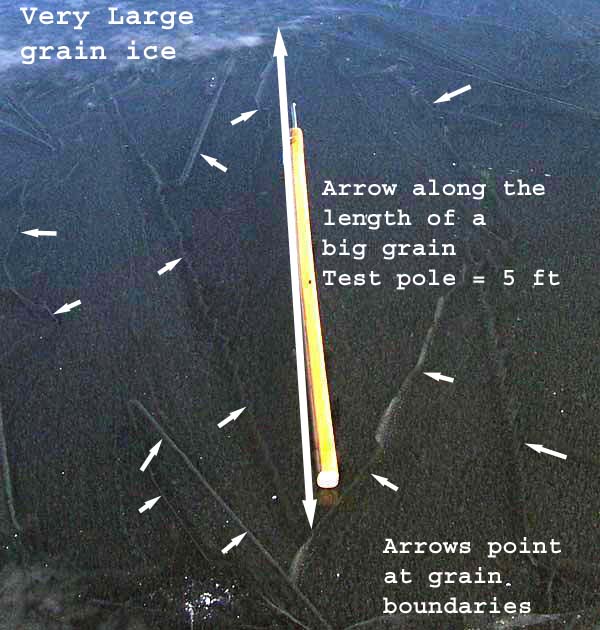 This is an especially large ice crystal. It is over 6 feet long.
This is an especially large ice crystal. It is over 6 feet long.
Large Grain Ice (Type S1)
In cold, still conditions with no snow falling the surface water will supercool. Once freezing is initiated ice crystals will form in long, flat spears (they can be seen in any still water in the process of freezing). If the cooling rate is reasonably low the spears are confined to a relatively thin supercooled layer on the surface of the water. The spears grow until they run into one another. They then fill the intervening surface with dendritic branches. Occasionally grains reach sizes of 6 feet or more but most of the time dimensions average 4 to 12”
In most cases this first thin skim of ice determines the grain structure for the ice as the sheet thickens. The grains mechanically lock together because the grain boundaries are relatively large planes which have larger scale interlocking features between the grains than are found on small grain ice.
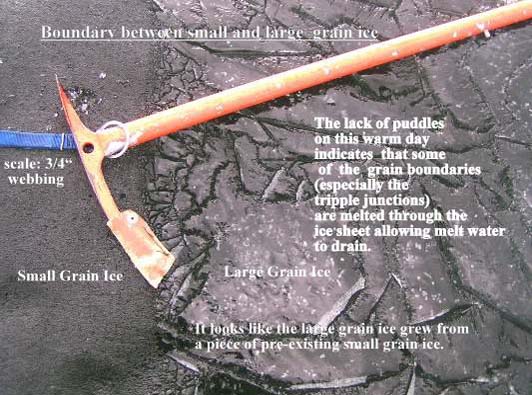 A boundary between small grain ice and large grain ice
A boundary between small grain ice and large grain ice
Small Grain Ice (type S2)
Small grain ice (also called: honeycomb, candle or pencil ice when it is well thawed) starts with many more nucleation sites. This is thought to be snow most of the time. Even a very light snow provides plenty of perfect nucleation sites to form a small grain structure. There is relatively little super cooling as the individual crystals are close together and the latent heat of crystallization keeps the water at 32 degrees.
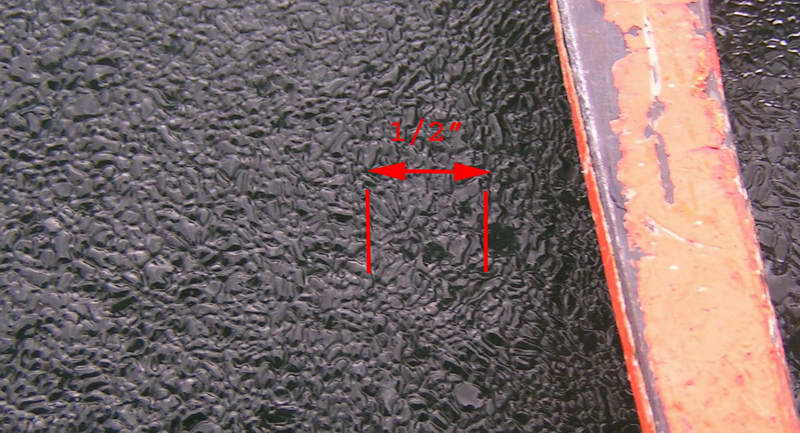 Very small ice grains
Very small ice grains
This ice typically has grain boundaries less than an inch apart. The This results in the long narrow grain structure typical of honeycomb ice. The grain boundaries of are much smaller than on large grains and the interlocking features are smaller as well. These features melt earlier in the thaw process than do the larger interlocking features of the large grain ice.
Thawing and grain size
The melting point of water is slightly lower at the grain boundary because the crystal structure is less perfect and because anything that was dissolved in the ice is pushed ahead of the solidification front as the crystal forms. Some of the salts and other disolved material ends up in the grain boundaries. This is a big factor with sea ice. The lower melting point results in the grain boundary faces and triple junctions melting first. This inter-grain melting is helped by the spring sun, which delivers some of its energy more deeply into the ice sheet. In an advanced thaw condition the grain boundaries melt completely. In small grain ice you end up with something like a bunch of irregular pencils held together only by the horizontal constraint of the ice sheet. Ice in this condition is a common reason for people and vehicles falling through. Often this occurs on a sunny day following a cold night that refroze the surface so the ice feels hard at the beginning of hte day. The firm feel and the prospect of a nice day lures people onto the ice but the overnight ice usually thaws again by mid to late morning.
The grain boundaries will melt all the way to the bottom of the ice, forming many tiny drain holes. One of the milestones in a thaw is when the surface puddles disappear by draining through these little drain holes.
You can test the degree of thaw by drilling a hole partially through the ice sheet. (3/4 depth is a good target). If water comes into the hole the deep ice is porous. If it comes in fast the ice is likely to be especially weak when the overnight ice softens.
If you are walking on thawed, small grain ice and it seems to shift downward under your foot it is the ice grains shifting by each other. This is a sign that you are on the wrong ice at the wrong time.
Strength of Thawed Ice
If you find yourself walking across well thawed spring ice, looking at the surface may tell you which ice is strongest. Small grain ice is typically dark with a small grain structure. It chips out into small columnar pieces when hit with your test pole. It may be possible to drive the test pole through a foot or more of this ice. If you can do this, you should have gotten off the ice a while ago.
A large grain ice surface looks very different (see picture above). It comes out in chunks rather than small chips when poked hard. In an advanced thaw condition, it is much stronger than small grain ice. A few years ago we were on some highly thawed ice (in dry suits, with rope and over a shallow, sandy bottom). Areas of large grain ice 4" thick held you if you kept moving. If you stood in one place it would sag several inches over 5-10 seconds before dropping you through. Nearby small grain ice about twice as thick would drop you through as soon as you stepped on it. This is something to consider when deciding where to make you next step if you have had the poor judgment to be out on ice like this.
It is common to have areas of different grain types mixed together. The size of sections of one ice type vary from entire lakes or bays to a patchwork of mixed pieces a few feet in size. During the ice formation process, broken up plates of one type often fill in with the other type.
Cobblestone Ice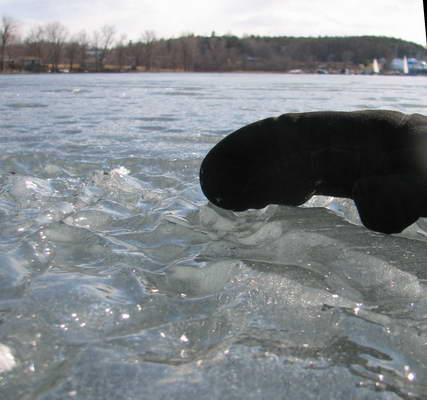 Cobblestone ice: Scale=about 5" from mitten thumb to end of mitten
Cobblestone ice: Scale=about 5" from mitten thumb to end of mitten
Cobblestone ice is a particularly rough ice surface that sometimes forms on large grain ice during a thaw.
More on Cobblestone Ice
More on Types of Ice
More on Ice Formation
More on the rate of ice thickening
More on Ice Engineering
